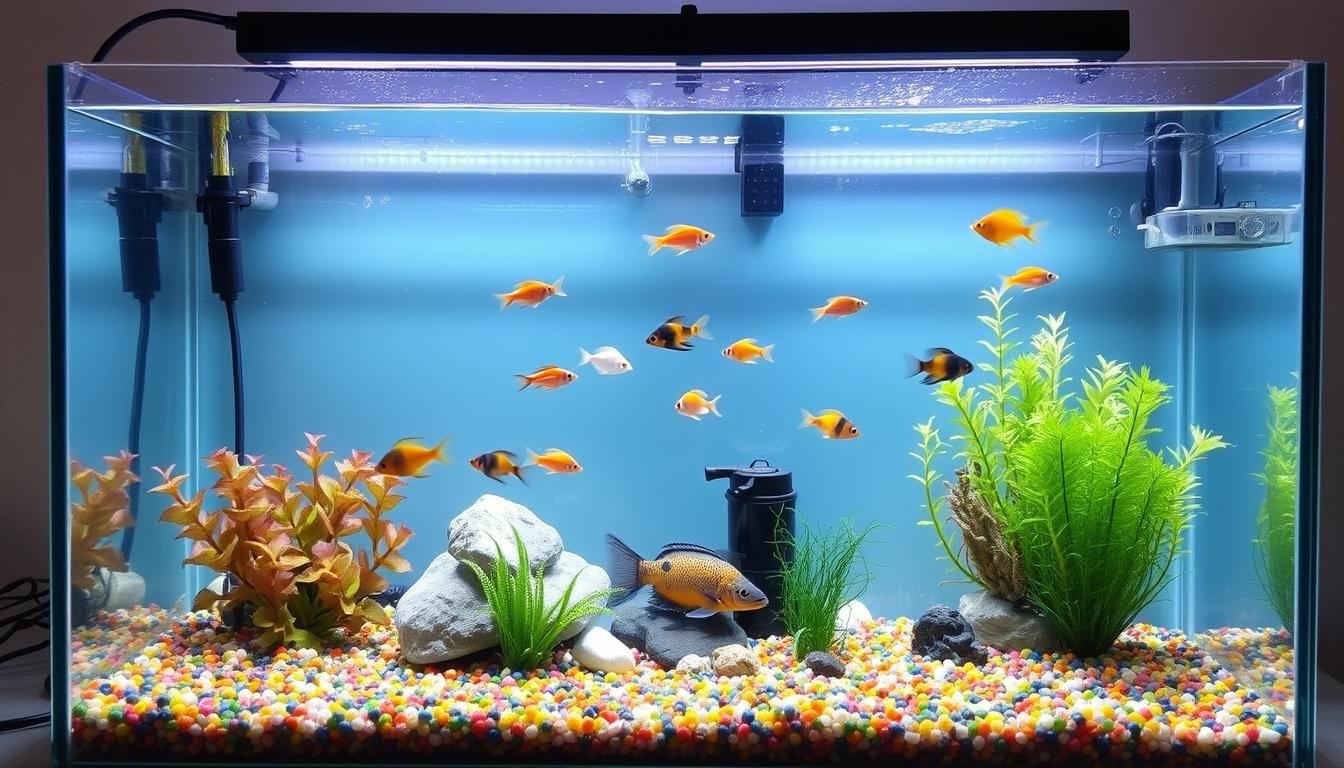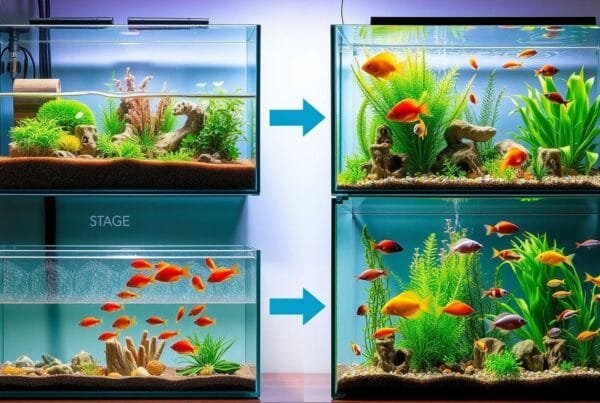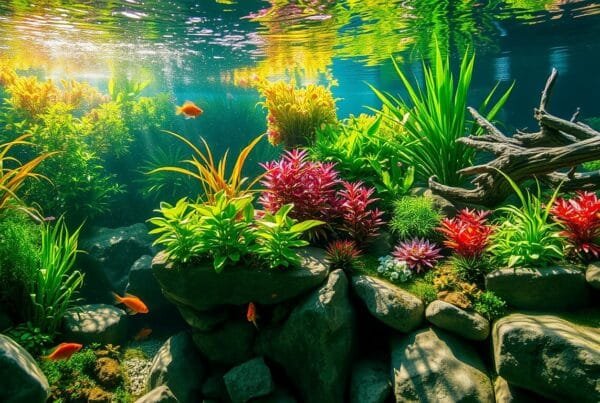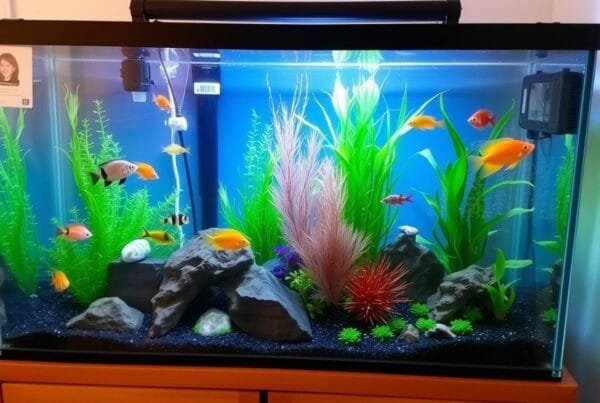Did you know setting up a fish tank can take about one to two weeks? You need to gather materials, install equipment, and start the aquarium cycling process. With the right gear and knowledge, you can create a thriving underwater world. To start with fish tank set up for beginners, it’s key to know the basics of fish tank equipment and beginner fish tank tips.
Setting up a fish tank step by step needs careful planning and attention to detail. You must choose the right tank size and pick the perfect fish species. Every step is important for a healthy and thriving environment for your fish. With the average time commitment of several hours per week, being prepared and dedicated is essential for your fish’s care.
Key Takeaways
- Setting up a fish tank can take about one to two weeks
- Choosing the right tank size is key, with a recommended size of 10 gallons for beginners
- Understanding fish tank equipment for beginners is essential for a thriving underwater ecosystem
- Beginner fish tank tips include regular water changes and monitoring water parameters at least once a week
- Setting up a fish tank step by step requires careful planning and attention to detail
- Regular maintenance is necessary, including cleaning gravel once a week and changing water twice weekly after the first month
- Proper acclimation techniques are vital for introducing new fish to the tank, including floating them in water for approximately 10 minutes prior to introduction
Essential Equipment for Your First Fish Tank
Setting up your first fish tank requires the right fish tank equipment. You’ll need a tank, a lid, a heater, a filter, and lighting. The tank size depends on the space you have and how many fish you want.
A good starting point is a 10-gallon tank. For smaller spaces, a 20-gallon tank works better. But, a 55-gallon tank is too big for most dorm rooms. Remember, the tank weighs about 10 pounds for every gallon of water.
Understanding filtration systems is key to keeping the water clean. A good filter should move the water 3-5 times the tank’s volume each hour. For a 20-gallon tank, the filter needs to handle at least 80 gallons per hour (GPH). For more tips on setting up your tank, visit this website.
You’ll also need a heater, lighting, and substrate for your tank. Don’t forget a good net and water conditioners. With the right fish tank equipment, you can create a great home for your fish.
Selecting the Perfect Location for Your Aquarium
Choosing the right aquarium location is key. The fish tank placement impacts your fish’s health. Look for a quiet, stable spot away from sunlight. It should also be close to a power outlet and water source.
Experts say a spot with easy access to both is best. This makes caring for your tank easier.
A good aquarium location is also in a quiet area. This reduces stress on your fish. Avoid areas with flashing lights or moving shadows, as they can stress your fish too.
For more tips on setting up a freshwater aquarium, check out this website.
Some key considerations for fish tank placement include:
- Proximity to a power source
- Access to a water source
- Low traffic area
- Away from direct sunlight
- Avoid areas with flashing lights or moving shadows

By picking the right tank location, you create a healthy home for your fish. Think about all these factors and take your time to find the perfect spot.
| Aquarium Location Considerations | Importance |
|---|---|
| Proximity to power source | High |
| Access to water source | High |
| Low traffic area | Medium |
| Away from direct sunlight | Medium |
| Avoid areas with flashing lights or moving shadows | Low |
Fish Tank Set Up for Beginners: Initial Assembly
Setting up your fish tank is key. First, install your filtration system to keep the water clean. Next, add substrate like gravel or sand to the bottom. Don’t forget decorations like plants or rocks.
Lighting and temperature control are also important. Make sure your lighting runs for up to 8 hours a day. This helps prevent algae. Adjust your temperature control based on your fish’s needs. Tropical fish like warmer water, while cold water fish prefer cooler temperatures.
For more tips on setting up a breeding tank, check out this guide. It offers a detailed guide on fish tank setup and care.
- Choose the right filtration system for your tank size and type of fish.
- Select a suitable substrate and add decorations to create a natural environment.
- Set up your lighting and temperature control systems according to your fish’s needs.
By following these steps, you can create a great home for your fish. Enjoy a successful fish tank setup.
Understanding Water Chemistry Basics
Keeping your aquarium healthy starts with knowing water chemistry basics. It’s important to understand the right levels of pH, ammonia, nitrites, and nitrates in your aquarium water. The pH should stay between 6.5 and 8.5. Ammonia, nitrites, and nitrates are harmful to fish and should be zero.
To keep your water healthy, do regular water changes and use a good filter. Also, check the levels of pH, ammonia, nitrites, and nitrates often. Here’s a quick guide to the ideal levels:
| Parameter | Ideal Level |
|---|---|
| pH | 6.5-8.5 |
| Ammonia | 0 |
| Nitrites | 0 |
| Nitrates | less than 20 ppm |
By keeping the right water chemistry levels, you make a great home for your fish. Always watch your aquarium water and adjust as needed. This will keep your fish happy and healthy.
The Nitrogen Cycle: Getting Your Tank Ready
Understanding the nitrogen cycle is key to a safe fish environment. It changes ammonia into nitrites, and then into nitrates. Cycling your tank helps grow good bacteria for this process.
To keep an eye on the nitrogen cycle, use test kits. They help track ammonia, nitrites, and nitrates. Aim for 0 ppm for ammonia and nitrites, and under 40 ppm for nitrates. Water changes and plants can lower ammonia levels.
- Use test kits to monitor ammonia, nitrites, and nitrates levels.
- Regular water changes can help reduce ammonia levels.
- Introduce plants to consume ammonia and nitrates.
By following these tips and understanding the nitrogen cycle, you can create a healthy and thriving environment for your fish.
| Parameter | Ideal Level |
|---|---|
| Ammonia | 0 ppm |
| Nitrites | 0 ppm |
| Nitrates | Below 40 ppm |
Choosing Your First Fish
When picking your first fish, it’s key to choose species that are easy for beginners. Guppies or neon tetras are great for new fishkeepers. It’s also important to think about compatibility to avoid aggressive or territorial fish.
Start by researching different fish species and their traits. Websites like Fishkeeping Adventure can help with this. Remember, the acclimation process is vital to prevent stress and disease in your fish.

- Temperament: Choose peaceful fish that are easy to care for.
- Size: Select fish that are suitable for your tank size.
- Swimming level: Consider fish that swim at different levels to create a visually appealing aquarium.
By considering these factors and doing your research, you can create a thriving and harmonious aquarium ecosystem. Always put your fish’s well-being and compatibility first. If unsure, don’t hesitate to ask for advice from experienced aquarists.
Establishing a Maintenance Schedule
To keep your aquarium healthy, it’s key to have a maintenance schedule. This means doing regular water changes, checking the tank’s water, and cleaning everything. A good maintenance schedule stops problems and keeps your fish happy.
A typical maintenance schedule for a fish tank includes:
- Weekly water changes of 10% to keep water quality good
- Checking temperature, pH, and salinity at least once a week
- Cleaning the tank and equipment, like siphoning water and removing algae
- Rinsing filter media every three to four months
Also, test for alkalinity and calcium weekly and clean algae from the glass at least every other day. By sticking to a regular tank maintenance plan, you can have a healthy and lively aquarium.
Remember, a steady maintenance schedule is vital for your fish’s health. By keeping up with water changes and tank maintenance, you’ll create a thriving underwater world.
| Maintenance Activity | Frequency |
|---|---|
| Water Changes | Weekly (10%) |
| Monitor Water Parameters | Weekly |
| Clean Tank and Equipment | Weekly |
| Rinse Filter Media | Every 3-4 months |
Troubleshooting Common Issues
Even with proper care, problems can pop up in your aquarium. Keeping an eye on your tank is key to spotting water quality problems early. These issues often creep up slowly. When troubleshooting these problems, figuring out the cause and fixing it is vital.
Cloudy water is a common problem. It might be from too much food, bad filtration, or other reasons. To fix it, do a water change and check your filters. Another issue is algae growth. This can be solved by cutting down on nutrients, like extra food or decaying plants.
For more info on setting up a freshwater aquarium, check out this guide. Some important tips include:
- Regular water changes (25% every 2-4 weeks)
- Proper filtration (mechanical, chemical, and biological)
- Monitoring water parameters (pH, ammonia, nitrite, and nitrate levels)
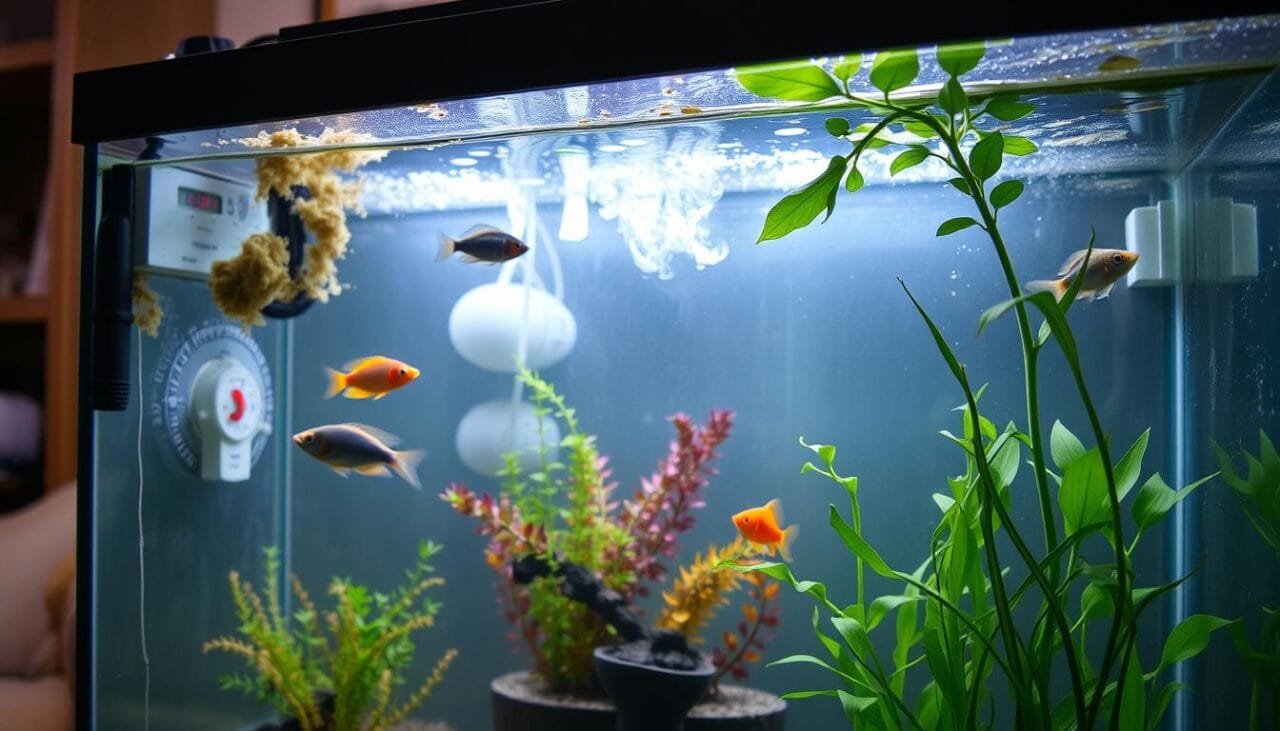
By following these tips and keeping an eye on water quality, you can make your aquarium a great place for your fish.
| Issue | Cause | Solution |
|---|---|---|
| Cloudy water | Overfeeding, poor filtration | Perform water change, check filtration system |
| Algae growth | Excess nutrients | Reduce nutrient availability, increase water changes |
| Water quality issues | Poor maintenance, inadequate filtration | Regular water changes, monitor water parameters |
Advanced Tips for Long-term Success
For long-term success in aquarium care, it’s key to use advanced tips beyond the basics. Keeping an eye on water levels like alkalinity, nitrate, and phosphate is vital. Regular water changes, like a 20% weekly swap, keep the water clean and stop pollutants from building up.
Investing in gear like an RO/DI filter can save a lot of money over time. Also, having a secondary heater helps control the temperature and avoids equipment breakdowns. By sticking to these advanced tips and focusing on aquarium maintenance, you can have a vibrant and healthy aquarium.
- Purchasing an RO/DI filter can save thousands of dollars over five years
- Regular water changes can limit pollutant buildup and maintain water quality
- Monitoring water parameters is key to avoiding equipment failure and keeping a healthy aquarium
| Equipment | Cost | Benefit |
|---|---|---|
| RO/DI filter | $200 upfront | Saves thousands of dollars over five years |
| Secondary heater | Varying costs | Regulates temperature and prevents equipment failure |
By using these advanced tips and staying dedicated to aquarium maintenance, you can achieve a thriving and healthy aquarium. This leads to long-term success.
Conclusion
Keeping a thriving ecosystem in your aquarium is key to a healthy environment for your fish. Regular aquarium maintenance is essential to ensure the well-being of your aquatic friends. By following the tips and techniques outlined in this article, you can create a balanced and thriving ecosystem in your aquarium.
Proper water quality is the foundation of a healthy aquarium. Regular water changes, monitoring parameters, and using appropriate filtration systems are all important steps to maintain optimal water conditions. By keeping the water clean and balanced, you provide a safe and healthy environment for your fish to thrive.
Providing a balanced diet is another critical aspect of aquarium maintenance. Researching and selecting the right food for your fish species is essential to ensure they receive the nutrients they need. Regular feeding and observing your fish’s behavior can help you determine if they are receiving a balanced diet.
Regular observation and monitoring of your fish’s behavior and health is vital to maintaining a thriving ecosystem. By observing any changes or signs of illness, you can take prompt action to address any issues and prevent them from becoming more serious problems.
By following these aquarium maintenance tips and techniques, you can create a thriving ecosystem in your aquarium. Remember, regular water changes, proper water quality, a balanced diet, and regular observation are all essential for the well-being of your fish. By prioritizing aquarium maintenance, you can ensure a healthy and thriving environment for your aquatic friends to enjoy.
FAQ
What are the essential equipment pieces I need to set up my first fish tank?
You’ll need a tank, a lid, a heater, a filter, and lighting to start.
How do I choose the right size tank for my first aquarium?
Start with a 10-gallon tank for beginners. The size depends on your space and how many fish you want.
Where is the best location to set up my fish tank?
Pick a quiet, stable spot away from sunlight. It should be near a power source and water for changes.
How do I properly set up the initial assembly of my fish tank?
First, install your filter. Then add substrate, decorations, lighting, and temperature control. This setup is key for a healthy tank.
What are the important water chemistry parameters I need to monitor in my fish tank?
Keep an eye on pH and levels of ammonia, nitrites, and nitrates. These are vital for your fish’s health.
What is the nitrogen cycle, and why is it important for my fish tank?
The nitrogen cycle is how bacteria clean the water. It’s essential for a healthy tank.
How do I choose the best fish species for my first aquarium?
Choose hardy, peaceful fish like guppies or neon tetras. Make sure they get along well.
What is a maintenance schedule, and why is it important for my fish tank?
A maintenance schedule keeps your tank healthy. It includes water changes, monitoring, and cleaning to prevent algae and bacteria.
What are some common issues I may encounter in my fish tank, and how do I troubleshoot them?
Issues like cloudy water or algae need quick fixes. Check the water and adjust as needed.
What are some advanced tips for maintaining the long-term success of my fish tank?
Regularly check water parameters and do water changes. Stay updated on aquarium care. Being ready to adapt is key.
